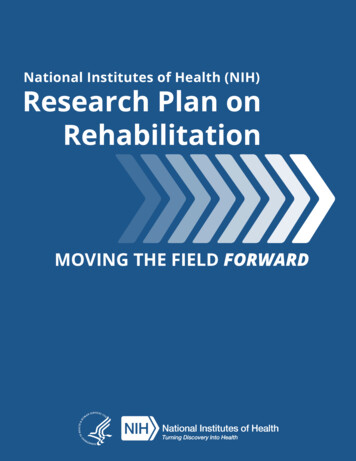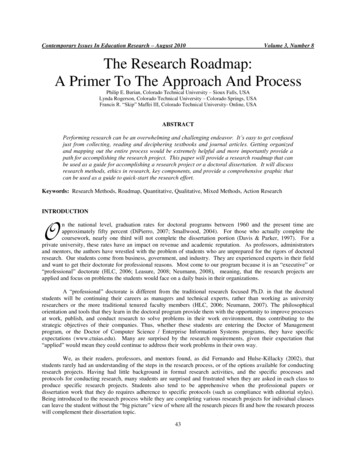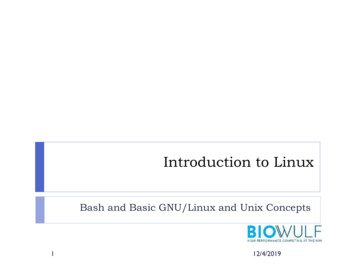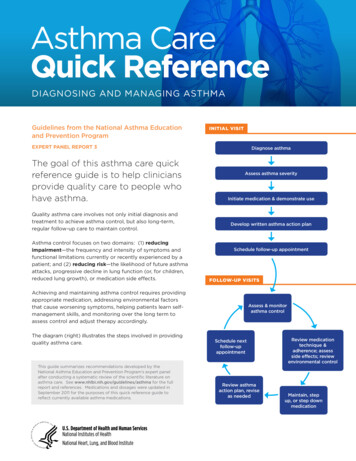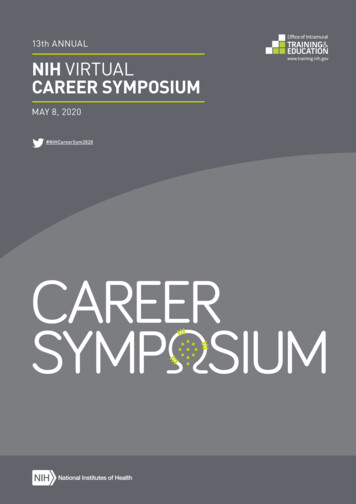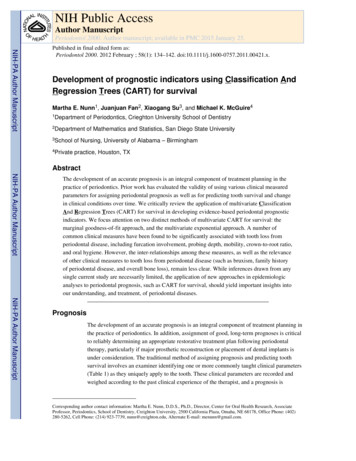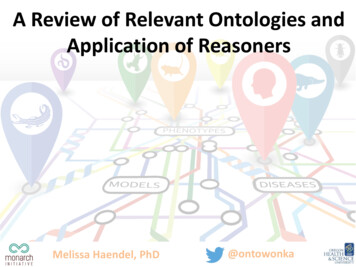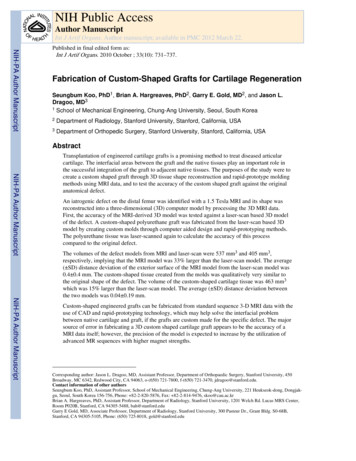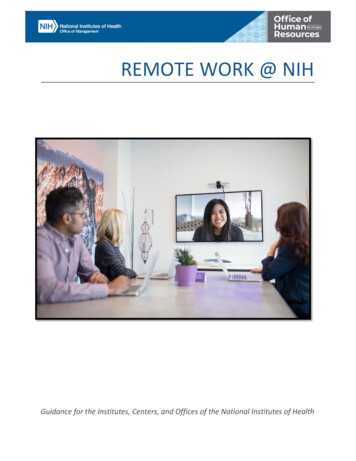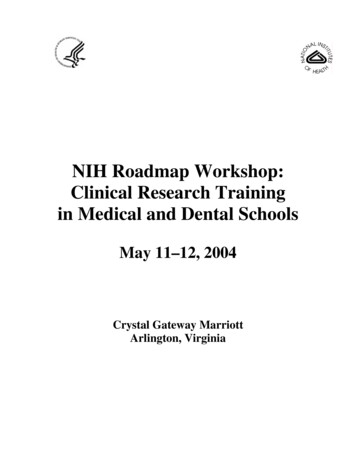
Transcription
NIH Roadmap Workshop:Clinical Research Trainingin Medical and Dental SchoolsMay 11–12, 2004Crystal Gateway MarriottArlington, Virginia
Table of ContentsIntroduction—The NIH Roadmap .Clinical Research Workforce Training.NIH Roadmap Workshop: Clinical Research Training in Medical and Dental Schools.112Clinical Research Training in the Medical Scientist Training Program . 3Program Description. 3Major Questions or Issues . 4Program Design. 5Why—Goals . 5Who—Selection of Students. 6When—Timing/Duration. 8What—Content/Skills. 9How—Methodology/Organization . 9Barriers and Solutions . 11Evaluation. 12Clinical Research Training in Master’s Programs .Program Description.Major Questions or Issues .Program Design.Why—Goals .Who—Selection of lls.How—Methodology/Organization .Barriers and Solutions .Evaluation.1313131414141416171820Clinical and Translational Research Training in Yearlong Pullout Programs .Program Description.Major Questions or Issues .Program Design.Why—Goals .Who—Selection of lls.How—Methodology/Organization .Barriers and Solutions .Evaluation.2020212121212223252526i
Short Courses in Clinical Research.Program Description.Major Questions or Issues .Program Design.Why—Goals .Who—Selection of lls.How—Methodology/Organization .Barriers and Solutions .Evaluation.2627272727282829293032Closing Remarks. 32Allocation Exercise . 32Summary Remarks . 33Participants. 35ii
NIH Roadmap Workshop:Clinical Research Trainingin Medical and Dental SchoolsMay 11–12, 2004Crystal Gateway MarriottArlington, VirginiaIntroduction—The NIH RoadmapUnder the leadership of Director Elias A. Zerhouni, M.D., the National Institutes of Health(NIH) has embarked on a multiyear process to identify major opportunities and gaps inbiomedical research that the NIH as a whole must address to optimize its entire research portfolioand make the biggest impact on the progress of medical research. This process, called the NIHRoadmap, outlines a vision for a more efficient and productive system of medical research andidentifies the most compelling opportunities in three main areas: New Pathways to Discovery,Research Teams of the Future, and Re-engineering the Clinical Research Enterprise. These areaswill provide the science, management, and personnel, respectively, to help the NIH catalyze thechanges needed to transform new scientific knowledge into tangible benefits for people.The third area of the NIH Roadmap will re-engineer the clinical research enterprise byadopting a systematic infrastructure that will better serve the evolving field of scientificdiscovery. Components of this roadmap area include expanding clinical research networks usingan informatics system called the National Electronic Clinical Trials and Research Network(NECTAR), translational research core services, and enhanced clinical research workforcetraining. This last component is the focus of the NIH Roadmap Workshop: Clinical ResearchTraining in Medical and Dental Schools.Clinical Research Workforce TrainingThe NIH Roadmap Trans-NIH Clinical Research Workforce Training Committee is exploringways to cultivate and train a cadre of clinical researchers who will have skills commensurate withthe increasing complexity and needs of the research enterprise. Duane Alexander, M.D., Directorof the National Institute of Child Health and Human Development (NICHD) and chair of theworking group, described the following areas of working group activity: Because research will be conducted increasingly in multidisciplinary settings, the NIHwill award five or six K121 institutional grants this summer to support post-doctoralcareer development in multidisciplinary clinical research. These grants help introducetrainees in different medical specialties to disciplines such as epidemiology,bioinformatics, clinical study design, and data management during the first year of theirtraining program. The NIH will reissue the Request for Applications (RFA) for K12grants for competition in fiscal year 2005.1 TheK12 Mentored Clinical Scientist Development Program Award provides support to an institution for thedevelopment of independent clinical scientists.1
The NIH has proposed a National Clinical Research Associates Program to increase theinvolvement of community-based practitioners in NIH clinical research. Physicians,dentists, and nurse practitioners who enlist in the program will enroll and follow theirpatients in NIH-supported clinical research, especially large-scale clinical trials. Thisapproach has the potential to enroll a patient population that would be morerepresentative of the overall U.S. population and to diffuse the innovations from the trialsinto clinical practice more rapidly. A feasibility study will examine issues such as theinterest and availability of community-based practitioners; the incentives, training, andinformatics linkages that would be needed; and the relative cost-effectiveness of theapproach compared to the current way of conducting clinical trials. The NIH has expanded the Clinical Research Training Program (CRTP) at the NIHClinical Research Center. The CRTP enables medical and dental students to spend a yearat the center participating in clinical research and to receive training in a number ofclinical research issues. This program was doubled in size, from 15 to 30 students peryear. The expansion of the CRTP without sacrificing the quality of participating studentsor mentors is the first concrete accomplishment of the NIH Roadmap. The NIH plans to address the issue of academic recognition for clinical investigators byconvening a meeting of leaders in academic medicine. The NIH is addressing the need to reach potential clinical researchers earlier in thepipeline through medical and dental schools. Graduates of the existing Medical ScientistTraining Program (MSTP), an integrated program of graduate training in the biomedicalsciences and clinical training offered through medical and dental schools, receives thecombined M.D.-Ph.D. degree. The majority of MSTP students pursue careers in basicbiomedical or clinical research. One focus of the current workshop is to explore the typesof incentives or modifications that should be added to the MSTP or whether analternative, parallel program should be developed to provide medical students withclinical research training as a primary, rather than secondary or incidental, focus.NIH Roadmap Workshop: Clinical Research Training in Medical and Dental SchoolsFor the current workshop, the working group convened NIH staff members and outsideexperts from the research community to obtain their advice as individuals on how best to design asystem that can support and encourage the development of a clinical research workforce amongmedical and dental students. The goals of the workshop are to address the following issues: How to increase the number of students in the pipeline who are entering clinical research How to attract and train future leaders in clinical research during medical and dentalschool How best to design clinical research training programs during the years in medical ordental school How to evaluate whether the clinical research training programs are meeting students’needs and making a difference2
How to initiate a viable career path and improve retention in the clinical research field How to set up a coordinated and consolidated continuum of programs that build on eachother and can be integrated into medical and dental school curricula What barriers can be expected and how they can be surmounted.The workshop was organized around four different models of clinical research workforcetraining that could be conducted in medical and dental schools. Plenary and breakout sessionsaddressed the following components: Clinical research training in the MSTP Clinical research training in Master’s degree programs Clinical and translational research training in yearlong pullout programs Short courses (e.g., summer or part-time courses) in clinical research.The diverse group of experts from academia and NIH were provocateurs, who presented anoverview and initial ideas for each type of training activity, and respondents, who provided initialcomments. All workshop participants had the opportunity to comment at the end of plenarysessions and during three periods of concurrent, small-group breakout sessions. The final day ofthe workshop included plenary summaries of breakout session discussions.Clinical Research Training in the Medical Scientist TrainingProgramProvocateurs: Eugene Orringer, M.D., University of North Carolina at Chapel Hill; and DavidRobertson, M.D., Vanderbilt UniversityRespondents: Gary Hunninghake, M.D., University of Iowa; Gary Koretzky, M.D., Ph.D.,University of Pennsylvania; and Peter Stacpoole, M.D., Ph.D., University of FloridaProgram DescriptionThe National Institute of General Medical Sciences established the MSTP in 1964. Eachyear, some 170 incoming medical and dental students (in about 40 different programs attending45 degree-granting institutions) receive support to pursue the combined M.D./Ph.D. degree. Mostof these students go on to successful careers in basic biomedical or clinical research.By integrating the spectrum of medical, dental, and graduate training required for theaggressive investigation of human disease, the MSTP is ideal for highly qualified candidates whocan benefit from a broad as well as selectively deep training experience during medical and dentaltraining. Graduates typically pursue a structured curriculum that can be tailored to their strengthsand interests. Although the goal of the program is to produce graduates who can functionindependently in both basic research and clinical investigation, most programs are flexibleenough to permit students to steer a course toward their chosen academic or clinical specialty.3
Participants in the breakout groups considered what issues must be addressed to increase thelikelihood that MSTP grantees will choose a career in clinical investigation and patient-orientedresearch (POR) if an RFA were developed to enhance the combined-degree pathway.Major Questions or IssuesBreakout groups identified the following basic questions that need to be answered beforefinal decisions are made about revising the MSTP: How can M.D./Ph.D. programs be framed and conducted to become a more coherentprocess for producing physician-scientists? An important consideration is that manygraduates obtain their most significant laboratory experience from the basic sciencecurriculum. Care must be taken not to endanger a manifestly successful program. What is the best conceptual model? The model must take into account that although amajority of MSTP candidates are “stem cells” (young college graduates who are eager toaggressively pursue a career in medicine), more than half of practicing clinicalinvestigators are “late bloomers” (medical and dental school graduates who may havefinished their residency and fellowships before migrating to clinical training). Does the interest in clinical research already exist? If not, how can it best be stimulated?Considerations include whether post-training incentives can be built into the MSTP tomake careers in clinical research more attractive and what unique incentives appeal topostgraduates. How can the Ph.D. component best be integrated into other existing professional degreeprograms for dental and nursing programs as well as medical schools? What balance should be struck between the didactic and the research components of theprogram? No standard, agreed-upon curriculum currently exists for training clinicalinvestigators. How well are the existing programs working? Students in the more prominent clinicalresearch Ph.D. programs usually have completed medical school and often residenciesand post-residency training programs. How can these existing programs be improved? Must advanced degree training in clinical research have a laboratory component?The breakout groups identified one evident and important threshold question: Should theNIH create a parallel but new program or incorporate reforms into the current MSTPinfrastructure? Consideration of this question raised the following points: Breakout group members were evenly split on this question before discussion began. Bythe end of the workshop, most members favored tweaking the existing program, althougha few maintained that institutions wanting to strike a new path should not be discouraged. The primary reasons for retaining the MSTP were its success in producing qualityphysician-scientists and the effective infrastructure established to implement the programat many participating institutions. Rather than have the MSTP compete with a new4
program for students or resources, participants thought it would be better to make theMSTP structure more flexible and provide more options so that institutions could tailorthe program to their own strengths and resources. The approach also would avoid theexpensive startup costs involved in creating a new infrastructure. The best strategy might be to find ways to take into account the idea that clinical researchinvolves a continuum and entails collaboration among professionals along a spectrum,from scholarly work to hypothesis-driven research to POR. One way to attract and train more clinical investigators might be to offer a new programthat would confer a dual degree by training medical and dental school students for aMaster’s degree in clinical research. Such a program might qualify for current MSTPsupport.Program DesignThe breakout groups developed numerous ideas about how to structure an RFA to enhancethe combined-degree pathway. After looking at physician-scientists who have emerged asclinical investigators, participants identified three different pathways to a career in clinicalresearch: Obtain both degrees at the same time (includes both the MSTP and other programs) Complete medical or dental school first, then obtain the Ph.D. degree Complete the NIH K12 program (1 year of didactic courses, with mentoring and alaboratory component).Why—GoalsThe following goals emerged from the breakout groups: The central goal of the combined-degree programs is to attract students with goodpotential and then guide them along the clinical research career path. Program designersneed to foster passion for clinical investigation and keep students on
year, some 170 incoming medical and dental students (in about 40 different programs attending 45 degree-granting institutions) receive support to pursue the combined M.D./Ph.D. degree. Most of these students go on to successful c
